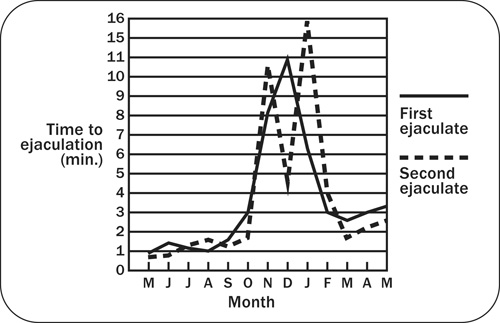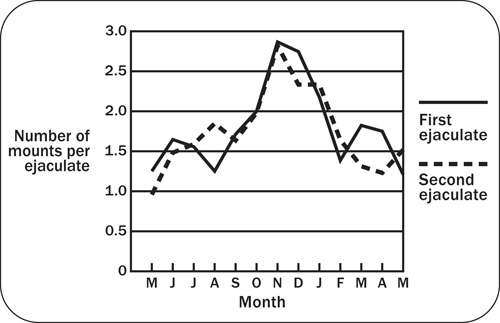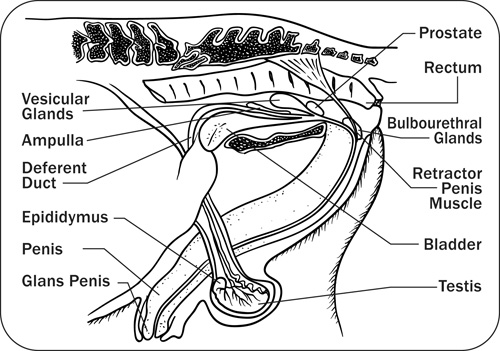Anatomy, physiology and reproduction in the stallion
Learn about the anatomy, physiology and reproductive management of the stallion.
ISSN 1198-712X, Published January 2011
Introduction
Horses have the potential for high reproductive performance. With an understanding of basic reproductive science, breeders can be better positioned to achieve their goals. This fact sheet presents information on basic anatomy, physiology and management techniques that can help improve reproductive performance in the stallion.
Hormones
Hormones are chemical substances created by the body that control various bodily functions. Some of the hormones involved in stallion reproduction are:
- Follicle-stimulating hormone — produced by the pituitary gland, stimulates sperm production.
- Luteinizing hormone and testosterone — necessary for completing the process of sperm production.
- Testosterone — promotes the development and function of the accessory sex glands, causes development of secondary sex characteristics and is necessary for mating activity, including sexual arousal, erection of the penis and ejaculation. Testosterone also promotes body growth.
Seasonality
As in the mare, reproductive performance of the stallion is affected by season, regulated by the influence of daylight hours on hormones. During the breeding season, April through August, stallions are more productive than in the fall and winter months in several ways:
- Greater seminal volume — During the summer months, the average mature stallion will produce approximately 8 billion sperm cells per day, with production being proportional to the size of the testes.
- Increased sexual response — Figure 1 shows the reaction time of stallions as influenced by season. During the breeding season, it took less than 2 min for the stallions to become sexually stimulated, mount and enter the artificial vagina. In the wintertime, the reaction time was in excess of 10 min. Therefore, when training the young stallion to breed, it is best to start in the normal breeding season.
- Increased ability to ejaculate — Figure 2 shows the seasonal influence on ability to ejaculate. In the normal breeding season, just over one mount per ejaculate was required, but in the non-breeding season, over 2.5 mounts per ejaculate was required on average.

Accessible description of Figure 1

Accessible description of Figure 2
Stallions are least fertile September to February, with fertility increasing in March and peaking in May and June. Fertility is still high but declining in July and August.
Anatomy
- Accessory Sex Glands — These glands contribute fluids and gel to the ejaculate but are not key to fertility.
- Vesicular Glands — The vesicular glands are accessory sex glands and add the gel fraction to the ejaculate.
- Bulbourethral, Vesicular and Prostate Glands — These are accessory sex glands that add fluids to the ejaculate.
- Deferent Duct — The deferent ducts transport sperm from the epididymis to the area of the accessory sex glands.
- Epididymis — The epididymis transports sperm from the testes to the deferent duct and is the area for concentration, maturation and storage of the sperm.
- Penis — The penis provides the means of penetration of the female reproductive system for semen deposition and is composed primarily of erectile tissue. The urethra is the tube that runs the length of the penis, conducting semen (or urine) to the outside.
- Glans Penis — This is the sensitive end of the penis that enlarges during excitation and copulation.
- Retractor Penis Muscle — This muscle retains the placid penis in the sheath and relaxes during erection.
- Scrotum — The main functions of the scrotum are to protect the testes and maintain them at a temperature several degrees lower than body temperature.
- Testes — There are two testes enclosed in the scrotum. The testes produce sperm cells and the male sex hormone testosterone. The testes should move freely within the scrotal sac and should be the same size, shape and texture (although the right is often slightly smaller than the left).

Accessible description of Figure 3
Fertility issues
- Hemospermia — In this condition, blood is found in the semen, rendering the sperm infertile. There are several possible causes. Call your veterinarian if there are indications of blood on the front of the back legs, dripping from the penis or in the semen.
- Klebsiella and B-hemolytic streptococci — Infected stallions tend to shed these organisms intermittently and mares tend not to conceive while the organisms are being shed. Positive diagnosis can be determined from a semen culture and/or a urethral and sheath swab following ejaculation. Although the infected stallion may spontaneously rid himself of the organisms, to date, treatment of infected stallions consists of cleaning and irrigating the sheath area (including the urethra) with glycerine and antibiotics, and treating the semen itself with antibiotics. Breeding by artificial insemination is the only effective method of reproduction for infected stallions.
- Equine Viral Arteritis (EVA) — All stallions intended for breeding should either be adequately vaccinated or tested annually for EVA. Manage EVA-positive stallions carefully and breed them only to immune mares, in order to control its presence within a breeding population. Mares infected after conception can abort.
- Overuse — Stallions can be temporarily infertile or subfertile when subjected to overuse. Appropriate frequency of use for breeding depends on the individual stallion's sperm production, viability and desire to breed. Some stallions can be used two or three times a day with no apparent problems, where once a day is too heavy for others. It is best to have a breeding soundness examination done on all stallions prior to the breeding season to determine individual schedules of use and number of mares to book to each stallion.
- Cryptorchidism — Sometimes one and rarely both testicles fail to descend from the abdominal cavity into the scrotum. This is known as cryptorchidism. The testicles of the male fetus are located in the abdomen, in a position similar to the ovaries of the female. It is the job of the gubernaculum, a ligament attached to the testicle at one end and the bottom of the scrotum at the other end, to contract, pulling the testicle through the inguinal canal into the scrotum. This process normally occurs at or shortly before birth. A unilateral cryptorchid can be fertile but should be castrated, since the condition is inherited.
- Illness — If a stallion becomes ill or an injury causes testicular temperature to become elevated, damage to stored spermatozoa occurs. As the time and temperature increase, recovery is prolonged. It takes approximately 60 days for a sperm cell to fully develop. If a stallion has been ill for a prolonged period of time with sufficient temperature elevation in the testes, the stallion could be infertile for up to 60 days after the temperature has returned to normal.
- Ejaculation — Sometimes a stallion will mount and go through the motions of breeding, yet not ejaculate. This may be due to overuse, a bad experience (kicked, mishandled while copulating), time of year or ejaculatory dysfunction. Multiple attempts may be required. Some indications of ejaculation include flagging of the tail, pulsations at the base of the penis, gel adhering to the end of the penis after dismounting and a cessation of interest in the mare.
Age and suitability
Horses reach puberty between 12 and 18 months of age. It is therefore advisable to keep colts and fillies separate once they reach 1 year of age. Even though young horses can reproduce, it is not advisable.
Test a stallion for mating when he is 2 or 3 years old, then put him into training and test his performance for 1 or 2 years. This gives the owner the opportunity to evaluate his performance potential and the outcomes of his offspring before establishing a program for him.
The age of the stallion affects the size and integrity of the testicular tissue, which influences sperm output. Total scrotal width increases until the stallion is at least 6 years of age. Sperm storage capacity is considerably larger in the mature stallion than in the 2- or 3-year-old. And as a general rule, the mature stallion produces more than twice the number of sperm per day as a 2- or 3-year-old. Thus, the 2- or 3-year-old stallion cannot be used as frequently as the mature stallion without reducing fertility.
Advanced age results in testicular degeneration, which reduces sperm output but does not influence semen quality in normal stallions.
Management
It is best to have the stallion enter the breeding season in excellent body condition, as some stallions will lose weight and condition during the season.
Stallions may be stabled apart from mares to decrease aggressive behaviour during handling. Stallions are often turned out in fields individually and not adjacent to fields with mares, or are turned out with geldings. Turning stallions out with mares with foals may also work, since mares with foals tend not to tolerate aggression from a stallion.
Train stallions to handle the breeding process properly. The stallion should approach the mare slightly to the left and from the rear, obtain an erection but not mount until the stallion handler allows him to. Once the stallion has mounted, he should be taught to remain mounted until he ejaculates and loses his erection. Handle stallions in a routine, disciplined manner at each breeding.
If a stallion is being bred more than once daily, it is best to space the sessions apart as much as possible throughout the day.
Lighting programs can artificially increase sperm production. To optimize sperm production, exposure to 16 hours of light is recommended. Exposure to more than 16 hours of light can cause a decrease in sperm production.
Following recommended management practices and understanding basic reproductive science of the stallion will improve chances for reproductive health and success of the stallion.
Reference
Pickett, B.W., and J.L. Voss. 1972. Reproductive management of the stallion. Proc. 18th Annual Convention. American Association of Equine Practitioners, p. 501.
Accessible image descriptions
Figure 1. Effect of season on sexual behaviour by time to ejaculation
Graph showing the effect of season on sexual behaviour as measured by time to ejaculation. Reaction time in minutes, on the y-axis. Time of year by month, on the x-axis. Time to first ejaculate peaks around December (11 minutes). Time to second ejaculate peaks around November and January (10.5 and 16 minutes respectively). Fastest times to first and second ejaculation during spring and summer months (1 to 2 minutes).
Figure 2. Effect of season on sexual behaviour by number of mounts required per ejaculation
Graph showing the effect of season on sexual behaviour as measured by number of mounts required per ejaculation. Number of mounts per ejaculate, on y-axis. Time of year by month, on the x-axis. Number of mounts required for ejaculation peaks at less than 3 around November for first and second ejaculate. Number of mounts required for ejaculation lowest in May for first ejaculate. Number of mounts required for ejaculation lowest around April and May for second ejaculate.
Figure 3. Sagittal view of stallion reproductive structures
Diagram of the reproductive tract of the stallion (sagittal view). Indicates vesicular glands, ampulla, deferent duct, epididymus, penis, glans penis, prostate, rectum, bulbourethral glands, retractor penis muscle, bladder, testis.